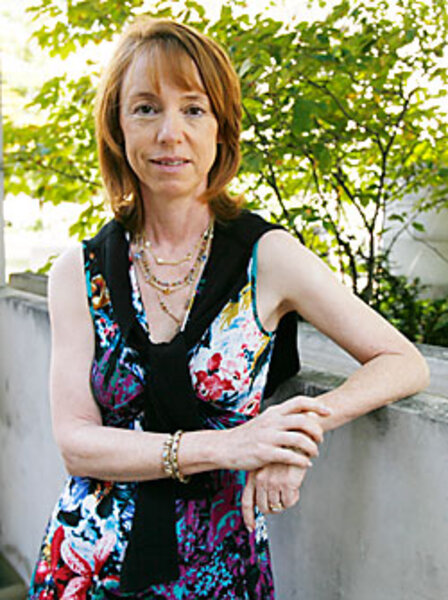Fall's bounty of books
Novelist Lisa See could be spending her September basking in the glow of three months on The New York Times bestseller list, but she has her eyes on another prize: keeping the competition at bay through Christmas.
Ms. See is stepping up her phone interviews to book clubs and participating in more online chats about "Shanghai Girls," her well-reviewed novel about two Chinese sisters who leave for America in the 1930s. It's all part of her "grass-roots" mission to make sure her book "doesn't fall off into the abyss" during the biggest sales season of the year.
It will be hard work, but See has one solace: At least her book has been on store shelves for a while. "I'm so glad I don't have a book coming out right around Dan Brown," she says.
But plenty of other big names have new novels in competition with Mr. Brown's near-guaranteed blockbuster, another sequel to "The Da Vinci Code." And therein lies the rub about this year's fall season in books: It's chock-full of star authors, a bounty that could pull the publishing industry out of its doldrums or leave few winners and many losers.
In addition to Brown, well-known novelists with new books on store shelves this fall include the late Michael Crichton, E.L. Doctorow, Barbara Kingsolver, Margaret Atwood, Thomas Pynchon, Richard Russo, and many more.
Add other complicating factors, such as the rise of books in electronic form and the desperate struggle of some booksellers, and the fall looks to be one humdinger of a season for publishers, stores, and authors, not to mention ordinary readers.
This fall has "a little more sense of urgency to it," says Arsen Kashkashian, inventory manager at Boulder Book Store in Colorado, expressing perhaps the most calm of anyone in the industry.
Literary agent Robert Gottlieb may be more representative when he puts it this way: "Fall has always been important, but never this important."
Particularly at stake, Mr. Gottlieb says, are the fates of publishing imprints and the struggling Borders chain of bookstores.
It has, after all, been a bad year for the book business, which has suffered from layoffs and cutbacks like other forms of media. "People said books were recession-proof, but that was only until there was a good-sized recession," says Mr. Kashkashian.
In the United States, book sales as a whole only fell by 1.5 percent from 2007 to 2008, according to the Book Industry Study Group. But at bookstore chains, sales dipped by 10 percent or more in late 2008, and they continued to slump this year. Borders, for example, saw sales drop by 12 percent in the first quarter of 2009.
If fewer books are selling, why are so many big books coming out in the next three months? It appears that publishers simply want to try to salvage a bad year.
"They have to do something to help improve their bottom line," says Gottlieb, since the holiday season is the biggest of all. This fall "will decide whether they have profits, were flat, or lost money."
Booksellers – and authors – hope the blockbusters will bring in customers to buy other books by less-famous writers. And bookstores certainly won't mind if readers buy nonfiction books, which seem likely to be also-rans this fall.
But it's difficult to predict what readers will do. Might they pick up the Dan Brown book at the local Costco and wander off in search of a giant tub of mayo instead of another literary stocking stuffer? Or will they decide to stay home and download Richard Russo's "That Old Cape Magic" to read on their Kindle for only $9.99?
That latter possibility is intriguing the publishing industry, which has seen a major increase of interest in e-books – those that can be read on the Kindle, other devices, iPhones, and even ordinary computers.
In the big picture, e-book sales are tiny, perhaps 1 to 3 percent of the total, although the numbers are higher in some genres, says consultant Mike Shatzkin, who advises publishers about digital media.
But e-books have the potential for plenty of growth, and some of their features – such as the Kindle's ability to download free sample chapters – could change the way readers buy books. Instead of skimming a page or two while standing in a Barnes & Noble, they could read a significant chunk of text before deciding whether to buy it.
The bounty of books this fall could be the turning point that persuades readers to jump into e-books, Mr. Shatzkin says. "I think you could expect to see a surge," he says. The fall "is a major opportunity to put a dipstick down to see what the extent of the change is" toward e-books.
The Dan Brown book in particular has the potential to be "the first blockbuster of the Kindle era," says Sara Nelson, columnist at The Daily Beast and former editor of Publishers Weekly.
If customers stay home or order online, the old-fashioned kind of bookstores that you visit in person – the independents, Barnes & Noble, Borders – could be in for more tough sledding this fall.
Companies like Borders, which has severe financial problems, could topple, agent Gottlieb says. "Barnes & Noble is in much better financial shape and could withstand difficult economic times better than Borders by comparison."
The good news for customers is that Borders continues to woo readers with surprisingly heavy discounts for those willing to use coupons they receive by e-mail.
Independent bookstores face challenges of their own. Many have closed as the recession has dragged on, and the wide availability of the Dan Brown book could mean fewer customers will need to seek it out at the local bookshop.
"We've adapted to what the economy is," says Kashkashian of the Boulder bookstore, who adds that his shop can survive another poor holiday season. For the second year in a row, however, he doesn't plan to hire extra help. Elsewhere, he says, some independent bookstores "are close to the edge and don't have any cash reserves, and it could be tough."
Amid worry, there's also plenty of optimism about the fall. As literary agent Sandra Dijkstra, who represents novelist See, puts it: "My feeling about it is that it's good for us all."
And readers, with the least at stake, may be the biggest beneficiaries.







